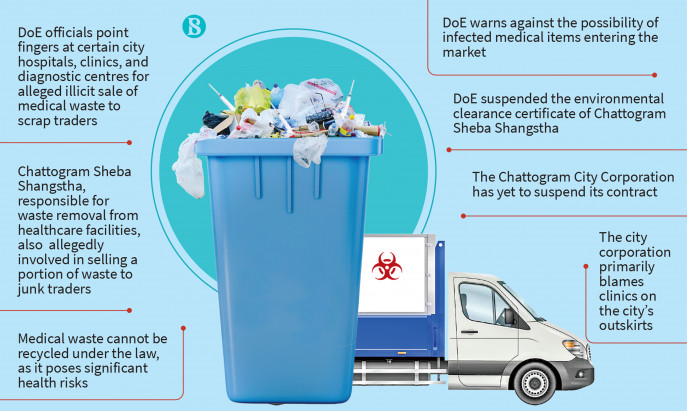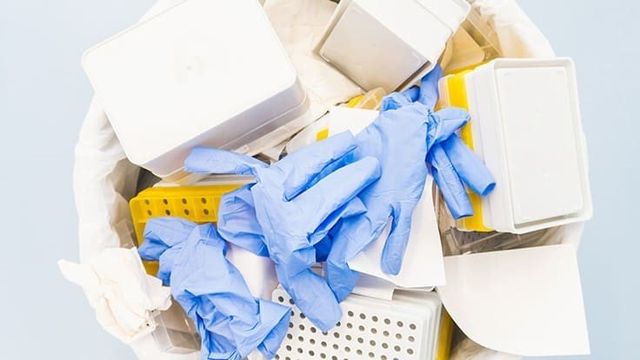Medical Waste Removal Mastery: Where Service Excellence Satisfies Health And Wellness Standards
Medical Waste Removal Mastery: Where Service Excellence Satisfies Health And Wellness Standards
Blog Article
Efficient and Eco Friendly Medical Waste Disposal Solutions
In the ever-evolving field of medical care, the issue of medical waste disposal remains a subject of critical importance. As healthcare facilities, facilities, and various other medical care centers make every effort to provide top quality person care, they have to also attend to the difficulty of successfully and sensibly taking care of their waste - medical waste removal services. In an age where environmental sustainability goes to the center of public awareness, discovering services that are both efficient and eco-friendly is not just a matter of conformity however additionally a testimony to the dedication of health care organizations in the direction of a greener future. From waste segregation methods to ingenious reusing efforts, this conversation will check out the numerous strategies employed to tackle this pushing issue, leaving you captivated and excited to check out the potential options that exist in advance.
Waste Segregation Practices
Reliable waste partition practices are vital to ensure the proper and secure disposal of clinical waste. Clinical waste, which includes materials contaminated with possibly contagious compounds, need to be handled in a manner that lessens the danger of harm to both public health and the environment. Proper waste partition plays an important function in attaining this goal.
Waste segregation involves the splitting up of various kinds of waste based upon their qualities and prospective dangers. This procedure makes sure that each type of waste is dealt with and thrown away properly (medical waste disposal services with WasteX). It begins at the point of generation, where medical care facilities must have marked containers and containers for various waste classifications, such as sharps, infectious waste, pharmaceutical waste, and non-hazardous waste
By setting apart medical waste at the resource, doctor can protect against cross-contamination and lower the threat of exposure to contagious representatives. This practice additionally assists in the recycling and healing of specific products. Segregating and reusing tidy plastics and glass minimizes the need for raw materials and decreases the environmental influence of clinical waste disposal.

Autoclaving and Sanitation Techniques
In order to make sure the safe and correct disposal of clinical waste adhering to efficient waste partition techniques, healthcare facilities have to use autoclaving and sterilization techniques. Autoclaving is a commonly utilized technique that uses high-pressure steam to disinfect clinical waste. This process includes placing the waste in a chamber and subjecting it to a combination of high temperature and stress, which effectively eliminates microorganisms and provides the waste safe for disposal. Autoclaving is specifically reliable in sanitizing items such as surgical tools, laboratory devices, and specific types of clinical waste that can withstand high temperatures. medical waste disposal services with WasteX.
This includes dealing with the waste with chemicals such as ethylene oxide or hydrogen peroxide, which eliminate bacteria by interrupting their mobile structure. It is essential to note that chemical sanitation calls for appropriate handling and disposal of the chemicals used, as they can be unsafe to human health and wellness and the setting if not taken care of appropriately.
On-Site Waste Therapy Systems
Health care facilities have actually executed on-site waste therapy systems to address the disposal of medical waste in a efficient and safe manner. These systems offer a economical and hassle-free solution for taking care of medical waste created within the center. On-site waste therapy systems utilize various technologies to get rid of and treat of medical waste on-site, reducing the need for transport to off-site facilities.
One frequently utilized on-site waste treatment system is the microwave modern technology. One more system is the chemical sanitation innovation, which involves treating medical waste with chemicals to eliminate virus and lower its harmful nature. medical waste disposal services with WasteX.
On-site waste treatment systems offer several advantages. They eliminate the threat of clinical waste being messed up during transport, minimizing the capacity for contamination and view it direct exposure to damaging substances. In addition, these systems assist healthcare facilities follow waste monitoring policies by supplying a efficient and convenient disposal technique. On-site therapy systems reduce the general ecological effect of medical waste by reducing transport and the need for landfill area.
Recycling and Repurposing Campaigns
As medical care facilities pursue lasting waste monitoring methods, they are significantly checking out recycling and repurposing initiatives as a way of minimizing the environmental impact of clinical waste. Reusing and repurposing campaigns include discovering cutting-edge methods to recycle or change medical waste into new products or products. This not just aids to lessen the volume of waste that ends up in incinerators or land fills yet likewise lowers the consumption of resources and energy required for producing new items.
One example of recycling in the medical care sector is the reprocessing of single-use medical tools. This not just minimizes the quantity of waste generated yet webpage also conserves medical care facilities significant expenses connected with purchasing brand-new devices.
One more reusing campaign involves the recycling of plastic containers, such as medicine bottles or syringe coverings. These containers can be accumulated, sorted, and sent out to recycling centers where they are processed, melted down, and changed into new plastic products. This assists to save sources and decrease the demand for virgin plastic manufacturing.
Along with reusing, repurposing campaigns include locating alternate usages for medical waste. Shredded paper waste from clinical records or product packaging products can be repurposed as bed linen material for animals or as insulation product. Likewise, natural waste such as food scraps from medical care centers can be composted and made use of as fertilizer in gardens or agricultural areas.

Renewable Resource Solutions
One efficient technique to minimizing the environmental impact of medical care procedures entails implementing renewable resource services. Medical care centers, such as centers and medical facilities, consume significant quantities of energy for various functions, consisting of illumination, home heating, cooling, and operating clinical tools. By transitioning to renewable power sources, these facilities can dramatically minimize their carbon footprint and add to a much more lasting future.

Executing renewable resource options in medical care centers not just decreases greenhouse gas discharges but also uses long-term price savings. While the preliminary financial investment in eco-friendly power framework may be greater, the long-term operational costs of renewable resource systems are considerably lower compared to traditional fossil fuel-based power resources. Additionally, renewable energy systems are reliable and can give a nonstop and secure power supply, ensuring continual health care solutions also during power outages or emergency situations.
Verdict
In conclusion, applying effective and environmentally pleasant clinical waste disposal services is necessary for maintaining a sustainable medical care system. By embracing waste partition methods, autoclaving and sanitation methods, on-site waste treatment systems, reusing and repurposing efforts, and eco-friendly power address solutions, health care centers can dramatically reduce their environmental impact.
It begins at the point of generation, where medical care facilities ought to have assigned bins and containers for different waste classifications, such as sharps, transmittable waste, pharmaceutical waste, and non-hazardous waste.
In order to ensure the risk-free and proper disposal of medical waste complying with reliable waste partition practices, health care centers must employ autoclaving and sanitation strategies.Health care facilities have applied on-site waste treatment systems to deal with the disposal of medical waste in a reliable and safe manner. On-site waste treatment systems use different modern technologies to dispose and treat of medical waste on-site, reducing the requirement for transportation to off-site facilities.
As health care centers aim for lasting waste administration methods, they are progressively checking out recycling and repurposing campaigns as a method of lowering the ecological influence of clinical waste. - medical waste removal services
Report this page